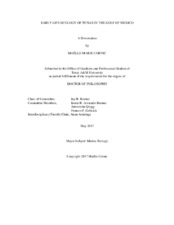| dc.description.abstract | Summer ichthyoplankton surveys were conducted in surface waters of the northern Gulf of Mexico from 2007 to 2010 to characterize distribution and abundance of tuna larvae. The assemblage of tuna larvae was comprised of four genera: Thunnus, Auxis, Euthynnus, and Katsuwonus. True tunas (genus Thunnus) were the most abundant, and four species were detected; Atlantic bluefin tuna (T. thynnus), yellowfin tuna (T. albacares), bigeye tuna (T. obesus), and blackfin tuna (T. atlanticus). Intra- and inter-annual variability in distribution and abundance of tuna larvae were observed with higher densities in 2008 and 2009 followed by a decline in abundance in 2010. Principal coordinate analysis (PCoA) and generalized additive models (GAM) based on presence/absence and density were developed to examine the impact of mesoscale features on distribution and abundance on true tuna larvae. Distribution and abundance of true tuna larvae in surface waters were influenced by physicochemical conditions of the water mass, notably sea surface temperature and salinity. Distinct species-specific habitat preferences, were observed and the location of mesoscale oceanographic features influenced larval abundance with higher densities of blackfin tuna, yellowfin tuna, and bigeye tuna associated with convergent zones near the margin of the Loop Current (LC) and other anticyclonic regions (warm core); bluefin tuna was observed in higher densities near cyclonic regions (cold core). Finally, habitat suitability maps were developed based on GAMs and environmental conditions to predict the spatial coverage of suitable habitat of blackfin tuna (2011 and 2015) and yellowfin tuna and bigeye tuna during the Deepwater Horizon oil spill (2010). Habitat suitability maps revealed that the amount of highly suitable habitat of blackfin tuna larvae varied between months (June 6%, July 51%); however, in both months larvae were distributed in similar locations along the continental slope and at the margin of the LC in the northern GoM. Similarly, the extent of highly suitable habitat for yellowfin tuna and bigeye tuna varied between June and July. A larger percentage of highly suitable habitat of bigeye tuna was exposed to surface oil (23-34%) compared to yellowfin tuna (4-26%), indicating that the oil spill might have impacted the two species differently. | en |


